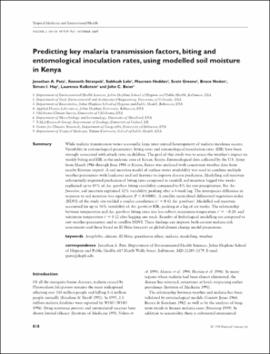| dc.contributor.author | Patz, Jonathan A. | |
| dc.contributor.author | Strzepek, Kenneth | |
| dc.contributor.author | Lele, Subhash | |
| dc.contributor.author | Hedden, Maureen | |
| dc.contributor.author | Greene, Scott | |
| dc.contributor.author | Noden, Bruce | |
| dc.contributor.author | Hay, Simon I. | |
| dc.contributor.author | Kalkstein, Laurence | |
| dc.contributor.author | Beier, John C. | |
| dc.date.accessioned | 2022-04-12T13:56:17Z | |
| dc.date.available | 2022-04-12T13:56:17Z | |
| dc.date.issued | 1998-10 | |
| dc.identifier | oksd_noden_predictingkeymalaria_1998 | |
| dc.identifier.citation | Patz, J. A., Strzepek, K., Lele, S., Hedden, M., Greene, S., Noden, B., ... Beier, J. C. (1998). Predicting key malaria transmission factors, biting and entomological inoculation rates, using modelled soil moisture in Kenya. Tropical Medicine and International Health, 3(10), pp. 818-827. https://doi.org/10.1046/j.1365-3156.1998.00309.x | |
| dc.identifier.uri | https://hdl.handle.net/11244/335206 | |
| dc.description.abstract | While malaria transmission varies seasonally, large inter-annual heterogeneity of malaria incidence occurs. Variability in entomological parameters, biting rates and entomological inoculation rates (EIR) have been strongly associated with attack rates in children. The goal of this study was to assess the weather's impact on weekly biting and EIR in the endemic area of Kisian, Kenya. Entomological data collected by the U.S. Army from March 1986 through June 1988 at Kisian, Kenya was analysed with concurrent weather data from nearby Kisumu airport. A soil moisture model of surface-water availability was used to combine multiple weather parameters with landcover and soil features to improve disease prediction. Modelling soil moisture substantially improved prediction of biting rates compared to rainfall; soil moisture lagged two weeks explained up to 45% of An. gambiae biting variability, compared to 8% for raw precipitatior. For An. funestus, soil moisture explained 32% variability, peaking after a 4-week lag. The interspecie difference in response to soil moisture was significant (P < 0.00001). A satellite normalized differential vegetation index (NDVI) of the study site yielded a similar correlation (r2 = 0.42 An. gambiae). Modelled soil moisture accounted for up to 56% variability of An. gambiae EIR, peaking at a lag of six weeks. The relationship between temperature and An. gambiae biting rates was less robust; maximum temperature r2 = -0.20, and minimum temperature r2 = 0.12 after lagging one week. Benefits of hydrological modelling are compared to raw weather parameters and to satellite NDVI. These findings can improve both current malaria risk assessments and those based on El Nino forecasts or global climate change model projection. | |
| dc.format | application/pdf | |
| dc.language | en_US | |
| dc.publisher | Wiley | |
| dc.relation.ispartof | Tropical Medicine and International Health, 3 (10) | |
| dc.relation.uri | https://www.ncbi.nlm.nih.gov/pubmed/9809915 | |
| dc.rights | This material has been previously published. In the Oklahoma State University Library's institutional repository this version is made available through the open access principles and the terms of agreement/consent between the author(s) and the publisher. The permission policy on the use, reproduction or distribution of the material falls under fair use for educational, scholarship, and research purposes. Contact Digital Resources and Discovery Services at lib-dls@okstate.edu or 405-744-9161 for further information. | |
| dc.subject.mesh | Animals | |
| dc.subject.mesh | Anopheles | |
| dc.subject.mesh | Humans | |
| dc.subject.mesh | Insect Bites and Stings | |
| dc.subject.mesh | Malaria | |
| dc.subject.mesh | Models, Biological | |
| dc.subject.mesh | Rain | |
| dc.subject.mesh | Soil | |
| dc.subject.mesh | Temperature | |
| dc.subject.mesh | Weather | |
| dc.title | Predicting key malaria transmission factors, biting and entomological inoculation rates, using modelled soil moisture in Kenya | |
| dc.date.updated | 2022-04-07T14:49:37Z | |
| osu.filename | oksd_noden_predictingkeymalaria_1998.pdf | |
| dc.description.peerreview | Peer reviewed | |
| dc.identifier.doi | 10.1046/j.1365-3156.1998.00309.x | |
| dc.description.department | Entomology and Plant Pathology | |
| dc.type.genre | Article | |
| dc.type.material | Text | |
| dc.subject.keywords | Prevention | |
| dc.subject.keywords | Infectious Diseases | |
| dc.subject.keywords | 2.2 Factors relating to the physical environment | |
| dc.subject.keywords | 1117 Public Health and Health Services | |
| dc.subject.keywords | Tropical Medicine | |
| dc.identifier.author | ScopusID: 7005533678 (Patz, JA) | |
| dc.identifier.author | ScopusID: 7003305696 (Strzepek, K) | |
| dc.identifier.author | ScopusID: 35966285500 (Lele, S) | |
| dc.identifier.author | ScopusID: 6602827371 (Hedden, M) | |
| dc.identifier.author | ScopusID: 7402744444 (Greene, S) | |
| dc.identifier.author | ORCID: 0000-0002-0096-370X (Noden, B) | |
| dc.identifier.author | ScopusID: 6601968347 (Noden, B) | |
| dc.identifier.author | ScopusID: 7101875313 (Hay, SI) | |
| dc.identifier.author | ScopusID: 7003310808 (Kalkstein, L) | |
| dc.identifier.author | ScopusID: 7102003162 (Beier, JC) | |
